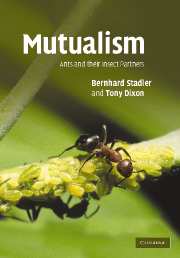4 - Mutualisms between ants and their partners
Published online by Cambridge University Press: 13 August 2009
Summary
Phylogeny and feeding ecology
Ants collect liquid food from caterpillars of the families Lycaenidae, Riodinide and Tortricidae (Maschwitz et al. 1986, Hölldobler and Wilson 1990, DeVries 1991a, Pierce et al. 2002), Sternorrhyncha (scale insects, aphids, white flies), Auchenorrhyncha (cicadas, leafhoppers, planthoppers) often summarized under the term ‘Homoptera’ (Buckley 1987, Wood 1993, Gullan and Kosztarab 1997, Delabie 2001, Stadler and Dixon 2005) and Heteroptera (Maschwitz et al. 1987, Hölldobler and Wilson 1990). In addition, they collect nectar from plants (Davidson et al. 2004, Oliveira and Freitas 2004). Many of these mutualisms are facultative and unspecialized, but the common denominator of all these associations is that they are driven by sugary excreta that are attractive to ants. Otherwise the life histories of these partners of ants are highly diverse. A crude characterization of the different taxa is that Sternorrhyncha and Auchenorrhyncha are often gregarious during some stage of their development, while many butterfly larvae have a more solitary lifestyle. Dispersal may occur in the early instars, as in many coccids (crawlers), while all other partners of ants disperse as adults. The beginning of the interactions between ants and other insects, in particular between ants and homopterans, dates back to the early Tertiary, because fossils in Baltic amber suggest that associations between aphids and Iridomyrmex spp. have existed since the early Oligocene (Wheeler 1910, Hölldobler and Wilson 1990).
- Type
- Chapter
- Information
- MutualismAnts and their Insect Partners, pp. 57 - 88Publisher: Cambridge University PressPrint publication year: 2008



